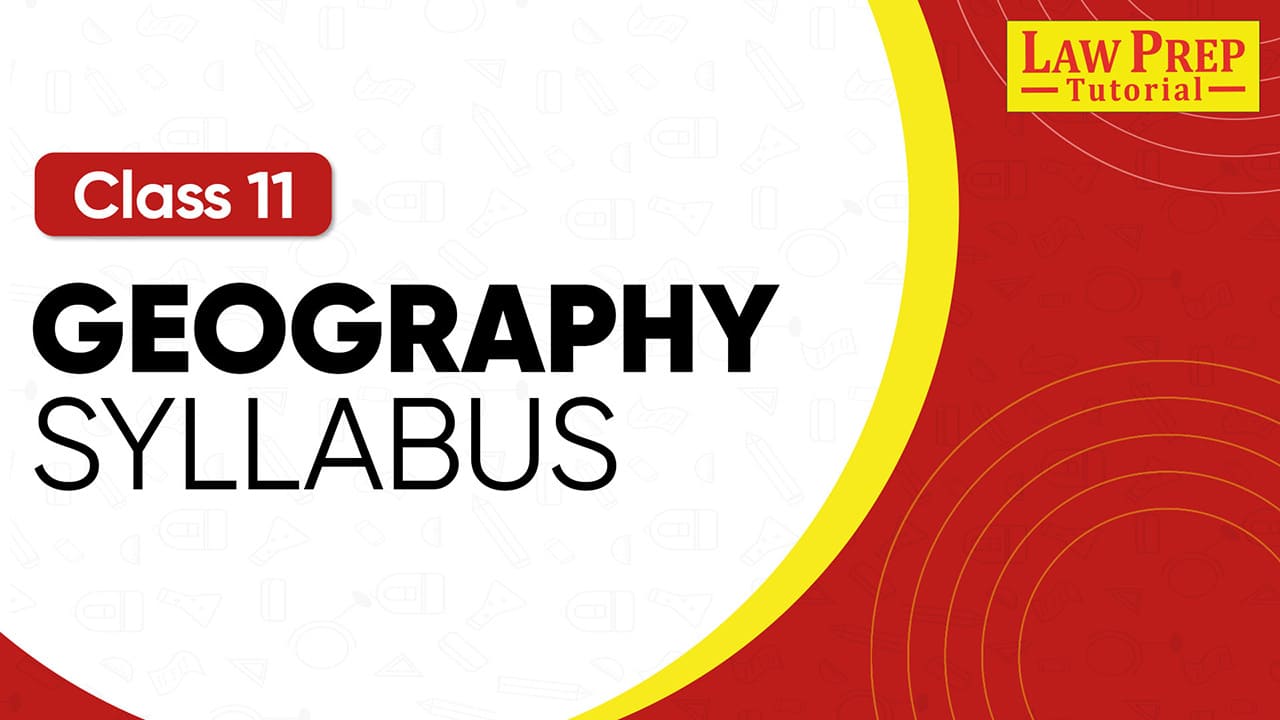Geography is one of the most important subjects in Class 11 as it helps you understand the Earth’s physical features, human environment, and the interaction between nature and society. The Class 11th Geography syllabus 2025-26 prescribed by CBSE focuses on both theoretical knowledge and practical skills.
It is divided into three parts: Fundamentals of Physical Geography, India: Physical Environment, and Practical Work. By studying the geography syllabus for class 11th, you will develop spatial understanding, analytical skills, and awareness about environmental issues that are essential for higher studies and competitive exams.
Class 11th Geography Syllabus 2025-26: Overview
Find the overview of class XI geography syllabus for CBSE and NCERT:
| Book Name | Units Covered |
| Book 1 – Fundamentals of Physical Geography | 6 Units |
| Book 2 – India: Physical Environment | 4 Units |
| Book 3 – Practical Work in Geography – I | 6 Chapters |
📥 Download Class 11 Geography Syllabus 2025-26 PDF
Download the complete CBSE Class 11 Geography Syllabus 2025-26 PDF and keep it for quick reference.
Class 11 Geography Syllabus 2025-26: Book 1
Book 1 – Fundamentals of Physical Geography
The Fundamentals of Physical Geography book introduces Earth’s structure, origin, landforms, atmosphere, climate, oceans, and biosphere. It helps students develop a scientific perspective of physical processes shaping our planet.
With chapters ranging from geomorphology to climatology and oceanography, the book lays the foundation for higher studies in physical geography and environmental science .
Unit I: Geography as a Discipline
This unit explains geography as a field of study. It highlights its relation with other sciences, branches of geography, and the importance of geographical inquiry. Students understand geography’s role as a bridge between natural and social sciences.
| Chapter | Topics Covered |
| Chapter 1: Geography as a Discipline | • Nature of geography • Relation with other sciences • Branches: Physical, Human, Biogeography • Significance of geography |
Unit II: The Earth
Covers Earth’s origin, evolution, and structure. It includes theories about the universe, earthquakes, volcanoes, and continental drift. Students understand plate tectonics and Earth’s internal dynamics.
| Chapter | Topics Covered |
| Chapter 2: Origin and Evolution of the Earth | • Big Bang Theory • Formation of stars/planets • Early and modern theories • Evolution of atmosphere, lithosphere, hydrosphere • Origin of life |
| Chapter 3: Interior of the Earth | • Sources of information • Earthquake waves, shadow zones • Structure of Earth • Volcanoes and landforms |
| Chapter 4: Distribution of Oceans and Continents | • Continental Drift Theory • Sea-floor spreading • Plate tectonics • Ocean floor configuration |
Unit III: Landforms
Focuses on geomorphic processes shaping landforms. Students study endogenic and exogenic processes such as weathering, erosion, deposition, and soil formation, along with resulting landforms like river valleys, deserts, coasts, and glaciers.
| Chapter | Topics Covered |
| Chapter 5: Geomorphic Processes | • Endogenic processes (diastrophism, volcanism) • Exogenic processes (weathering, landslides) • Soil formation |
| Chapter 6: Landforms and their Evolution | • Fluvial, Aeolian, Glacial, Coastal, Karst landforms • Erosional and depositional features |
Unit IV: Climate
Explains atmosphere, weather, and climate systems. It covers solar radiation, heat balance, temperature, winds, air masses, cyclones, rainfall, and world climate. Students also explore climate change and global warming.
| Chapter | Topics Covered |
| Chapter 7: Composition and Structure of Atmosphere | • Structure and layers • Elements of weather and climate |
| Chapter 8: Solar Radiation, Heat Balance and Temperature | • Insolation • Heating and cooling processes • Heat budget • Temperature distribution |
| Chapter 9: Atmospheric Circulation and Weather Systems | • Pressure systems • Winds (planetary, seasonal, local) • Cyclones • Jet streams |
| Chapter 10: Water in the Atmosphere | • Humidity, condensation, precipitation • Types of rainfall |
| Chapter 11: World Climate and Climate Change | • Climate classification • Global warming • Climate change impacts |
Unit V: Water (Oceans)
Introduces hydrosphere and oceans. Students study distribution of water, hydrological cycle, ocean relief, temperature, salinity, and movements of ocean water such as waves, tides, and currents .
| Chapter | Topics Covered |
| Chapter 12: Water (Oceans) | • Hydrological cycle • Ocean relief • Temperature and salinity distribution |
| Chapter 13: Movements of Ocean Water | • Waves • Tides • Ocean currents |
Unit VI: Life on the Earth
Explains biosphere, ecosystems, biodiversity, and conservation. Students learn about interdependence of organisms, ecological balance, and the need for conservation of natural resources.
| Chapter | Topics Covered |
| Chapter 14: Biodiversity and Conservation | • Ecosystem • Biodiversity types • Conservation strategies |
More Important Resources for CBSE Exam:
| Class 11th Hornbill Syllabus | CBSE Class 11th Commerce Subjects |
| CBSE Full Form | All about CBSE Class 11th |
| Class 11th Syllabus | Class 12th Syllabus |
| Class 11th Commerce Books | CBSE Board: All details |
Class 11 Geography Syllabus 2025-26: Book 2
Book 2 – India: Physical Environment
This book in the CBSE class 11th geography syllabus explores the physical geography of India, including its location, geological structure, landforms, climate, drainage, vegetation, soils, and natural hazards.
It helps students understand how India’s diverse environment shapes human and economic activities. Emphasis is placed on disaster awareness and sustainable management of natural resources .
Unit I: Introduction
Covers India’s geographical location, size, latitudinal and longitudinal extent, and its neighbors. It highlights India’s strategic position and its significance in Asia and the world.
| Chapter | Topics Covered |
| Chapter 1: India – Location | • Location and size • Latitudinal and longitudinal extent • Indian Standard Time (IST) • India and its neighbors |
Unit II: Physiography
Explains India’s geological structure and physiographic divisions. Students study the Northern and North-Eastern Mountains, Northern Plains, Peninsular Plateau, Indian Desert, Coastal Plains, and Islands, along with drainage systems of India.
| Chapter | Topics Covered |
| Chapter 2: Structure and Physiography | • Geological structure of India • Physiographic divisions (Himalayas, Northern Plains, Plateau, Desert, Coasts, Islands) |
| Chapter 3: Drainage System | • Drainage patterns • River basin, catchment, watershed concepts • Himalayan and Peninsular river systems • Usability of river water, interlinking of rivers • Problems and water pollution |
Unit III: Climate, Vegetation and Soil
Focuses on factors influencing India’s climate and monsoon system, distribution of rainfall, and climate variability. Also covers natural vegetation types, wildlife conservation, soil types, erosion, and soil conservation practices.
| Chapter | Topics Covered |
| Chapter 4: Climate | • Weather and climate • Unity and diversity of monsoon climate • Factors influencing climate • Monsoon mechanism • Seasons of India • Rainfall distribution • Economic significance • Global warming |
| Chapter 5: Natural Vegetation | • Major vegetation types • Forest distribution • Conservation measures • Wildlife reserves, biosphere reserves |
Unit IV: Natural Hazards and Disasters: Causes Consequences and Management
Deals with causes, consequences, and management of natural hazards and disasters in India such as earthquakes, floods, droughts, and cyclones. Focus is on disaster preparedness, risk reduction, and sustainable development .
| Chapter | Topics Covered |
| Chapter 6: Natural Hazards and Disasters | • Types of natural hazards • Earthquakes, floods, droughts, cyclones • Consequences • Disaster management strategies |
Check the latest CBSE Class 11 syllabus for all subjects below:
Class 11th Geography Syllabus 2025-26: Book 3
Book 3 – Practical Work in Geography (Part I)
This book for the syllabus of class 11th geography subject builds practical skills in geography, including map-reading, cartographic techniques, data presentation, remote sensing, and field surveys.
It aims to give students hands-on experience in interpreting geographical information, preparing thematic maps, and conducting surveys. These practical exercises are vital for applying theoretical knowledge to real-world geographical problems.
| Chapter No. | Chapter Name | Weightage |
| 1 | Introduction to Maps | 3 |
| 2 | Map Scale | 4 |
| 3 | Latitude Longitude and Time | 4 |
| 4 | Map Projections | 4 |
| 5 | Topographical Maps | 4 |
| 6 | Introduction to Remote Sensing | 5 |
| Practical File and Viva | 6 | |
| Total | 30 |
Class 11 Geography Syllabus: Question Paper Design
| Part / Book | Marks |
| Book 1 – Fundamentals of Physical Geography | 35 |
| Book 2 – India: Physical Environment | 35 |
| Book 3 – Practical Work in Geography – Part I | 30 |
| Total | 100 |
Prescribed Books for Class 11 Geography Syllabus (2025-26)
The following NCERT books are prescribed by CBSE for Class 11 Geography:
- Fundamentals of Physical Geography: Class XI, NCERT
- India: Physical Environment: Class XI, NCERT
- Practical Work in Geography: Part I, Class XI, NCERT
These books are compulsory for Class 11 students and form the basis for both theory and practical examinations. They also provide the foundation for higher-level geography studies and competitive exams.
Suggested Project Work for Class 11 Geography Syllabus
Project and activity work form an integral part of the syllabus of Geography subject for Class 11th. These tasks aim to build practical understanding, research skills, and field experience. Students are expected to prepare one project file based on field surveys, data collection, or thematic analysis.
- Study of a local river: its course, pollution issues, and conservation measures.
- Comparative analysis of land use patterns in rural and urban areas.
- Survey of natural vegetation in a local park or forest area.
- Study of soil types and fertility in the local area.
- Preparation of thematic maps on rainfall, temperature, or population distribution.
- Field visit to interpret topographical maps and record observations.
- Case study on natural disasters (earthquake, flood, drought, cyclone) in India.
- Impact of climate change on local agriculture or water resources.
- Use of remote sensing and satellite images for understanding land use changes.
- Analysis of settlement types and patterns in a nearby locality.
Read the chapter-wise summaries of Class 11 English here:
Objectives of Class 11 Geography Syllabus 2025-26
- Understanding Earth’s Systems: To study the physical features of the Earth, including landforms, climate, oceans, and ecosystems.
- Developing Spatial Thinking: To enhance map-reading and spatial analysis skills using topographical maps, thematic maps, and satellite images.
- Exploring India’s Physical Environment: To gain knowledge about India’s physiography, climate, vegetation, soils, and natural hazards.
- Linking Nature and Human Activities: To analyze the interdependence of physical processes and human activities, and their impact on the environment.
- Promoting Environmental Awareness: To develop sensitivity towards environmental issues, natural resource management, and disaster preparedness.
- Strengthening Practical Skills: To apply statistical methods, graphical techniques, and field survey methods in analyzing geographical data.
- Preparing for Higher Studies and Careers: To provide a strong foundation for further studies in geography, environmental sciences, urban planning, disaster management, and competitive exams.
Tips to Prepare for Class 11 Geography Syllabus 2025-26
- Read NCERT Books Thoroughly: Stick to the three prescribed NCERT books. Every exam question is directly or indirectly based on them.
- Make Notes for Each Chapter: Prepare short notes, flowcharts, and diagrams for quick revision. Highlight definitions, key terms, and examples.
- Practice Map Work Regularly: Maps are scoring. Practice topographical maps, river systems, climatic regions, soils, and vegetation maps frequently.
- Focus on Diagrams and Graphs: Geography is a visual subject. Practice drawing and labeling diagrams, climatic graphs, and statistical charts.
- Revise Units in Order: Cover physical geography first, then India’s geography, and finally practical work. This sequence builds a strong base.
- Solve Previous Year Papers: Attempt past CBSE papers and sample papers to understand the exam pattern and important topics.
- Prepare for Practicals Early: Don’t ignore the Practical Work in Geography. Practice scale conversion, topographical maps, and statistical diagrams from the start.
- Stay Updated with Current Affairs: Relate classroom concepts with real-world issues like floods, earthquakes, climate change, and conservation projects for better retention.
FAQs About CBSE Class 11 Geography Syllabus
There are 16 units in total – 6 in Fundamentals of Physical Geography, 4 in India: Physical Environment, and 6 in Practical Work in Geography – Part I.
Yes, map work is an important part of the CBSE Class 11 Geography syllabus. It includes interpretation of topographical maps, thematic maps, and India/world map questions.
The units cover Geography as a discipline, Earth’s origin and interior, landforms, climate, oceans, and biosphere.
It includes India’s location, geological structure, physiography, drainage system, climate, natural vegetation, soils, and natural hazards/disasters.
It involves map scale, topographical maps, data presentation through graphs and diagrams, thematic mapping, aerial photographs, and basics of remote sensing.
There are 21 chapters in total across the three prescribed books.
Practical Work carries 30 marks out of 100, which includes lab exercises, record/viva, and practical test.
Yes, Geography is considered a scoring subject as it combines theory with maps, diagrams, and practical work. Clear concepts and practice of diagrams/maps help students secure high marks.
Yes, NCERT books are sufficient for the Class 11 Geography syllabus as per CBSE guidelines. For practice, students may refer to sample papers and question banks.
Yes, Class 11 Geography syllabus builds a strong base for UPSC, State PSC, and entrance exams like CUET, as it covers both Indian and World Geography.
Yes, under India: Physical Environment, Unit IV deals with Natural Hazards and Disasters like earthquakes, floods, droughts, and cyclones.
Find detailed questions and answers from all chapters of English Class 11 now:
Explore the updated CBSE Class 12 syllabus for all subjects here:
Discover CLAT exam resources that can help you get started early:
Explore CLAT coaching centers across different cities:


